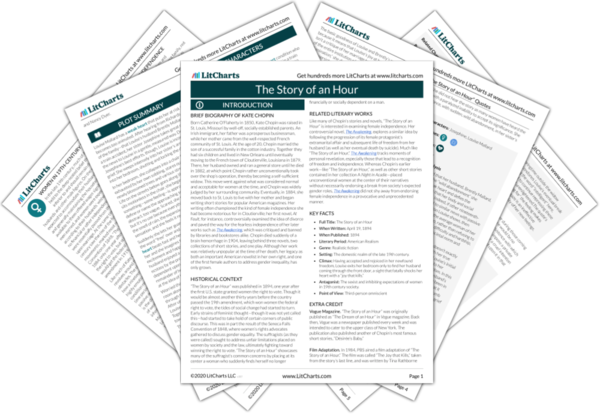In the late 19th century, much of American society held to the deep-seated belief that women were inferior to and should remain dependent upon husbands and other male figures. On the whole, women were expected to accommodate their husbands by cooking, cleaning, and generally maintaining the household. Any employment available to them offered wages significantly less than what men earned, and women were expected to conduct their lives according to their husbands’ wishes. Most women had little or no financial or other independence, as they (and their finances) were essentially passed from their fathers to their husbands upon marriage. At the same time, the second half of the 19th century saw the rise of the first organized women’s rights movements, marked most notably by the Seneca Falls Convention of 1848. “The Story of An Hour” was published in 1884, only one year after the first U.S. state granted women the right to vote, but still almost three decades before women would get the federal right to vote through the 19th amendment in 1919.
Like much of Kate Chopin’s work, “The Story of an Hour” revolves around the idea of female independence and its obstacles. The story is especially concerned with examining how a nineteenth-century woman was expected to behave in highly emotional circumstances. Louise Mallard’s heart condition renders her physically weak, further enforcing the time period’s prevailing sentiment that women should remain passive and unexcited. At the same time, one might argue that it is the diagnosis of the heart condition itself that enforces a kind of weakness on Louise based on the assumptions about women inherent in the diagnosis.
More particularly, though, through the sudden death of Louise’s husband in an accident, the story portrays a woman on the cusp of true independence in the only way that was truly available to women at the time: through the death of a wealthy husband, leaving the woman with her own fortune and no need to remarry to maintain her station in life. And so, despite her real grief at her husband’s unexpected death, Louise feels intense joy at the exceedingly rare prospect being granted to her as a woman: the chance to be “free, free.”
And yet, the story also implies the way that society, and perhaps even the world itself, resists any woman having such freedom. It does so most obviously through its literal shock ending, in which Louise’s husband turns out not to have been in the accident after all and walks through the front door, a revelation that stops Louise’s heart. But the story also makes this implication more subtly, as when Louise’s sister worries that Louise is making herself sick by remaining isolated in her room (though in truth Louise is reveling in her freedom). Both men and women of the society around Louise intervene in her life, ultimately proving that her freedom is impossible to hold.
Women in 19th-Century Society ThemeTracker

Women in 19th-Century Society Quotes in The Story of an Hour
She did not hear the story as many women have heard the same, with a paralyzed inability to accept its significance. She wept at once, with sudden, wild abandonment, in her sister’s arms.
It was not a glance of reflection, but rather indicated a suspension of intelligent thought.
There was something coming to her and she was waiting for it, fearfully.
There would be no one to live for her during those coming years; she would live for herself. There would be no powerful will bending hers in that blind persistence with which men and women believe they have a right to impose a private will upon a fellow-creature. A kind intention or a cruel intention made the act seem no less a crime as she looked upon it in that brief moment of illumination.
What could love, the unsolved mystery, count for in face of this possession of self-assertion which she suddenly recognized as the strongest impulse of her being!
She arose at length and opened the door to her sister’s importunities. There was a feverish triumph in her eyes, and she carried herself unwittingly like a goddess of Victory. She clasped her sister’s waist, and together they descended the stairs.
















